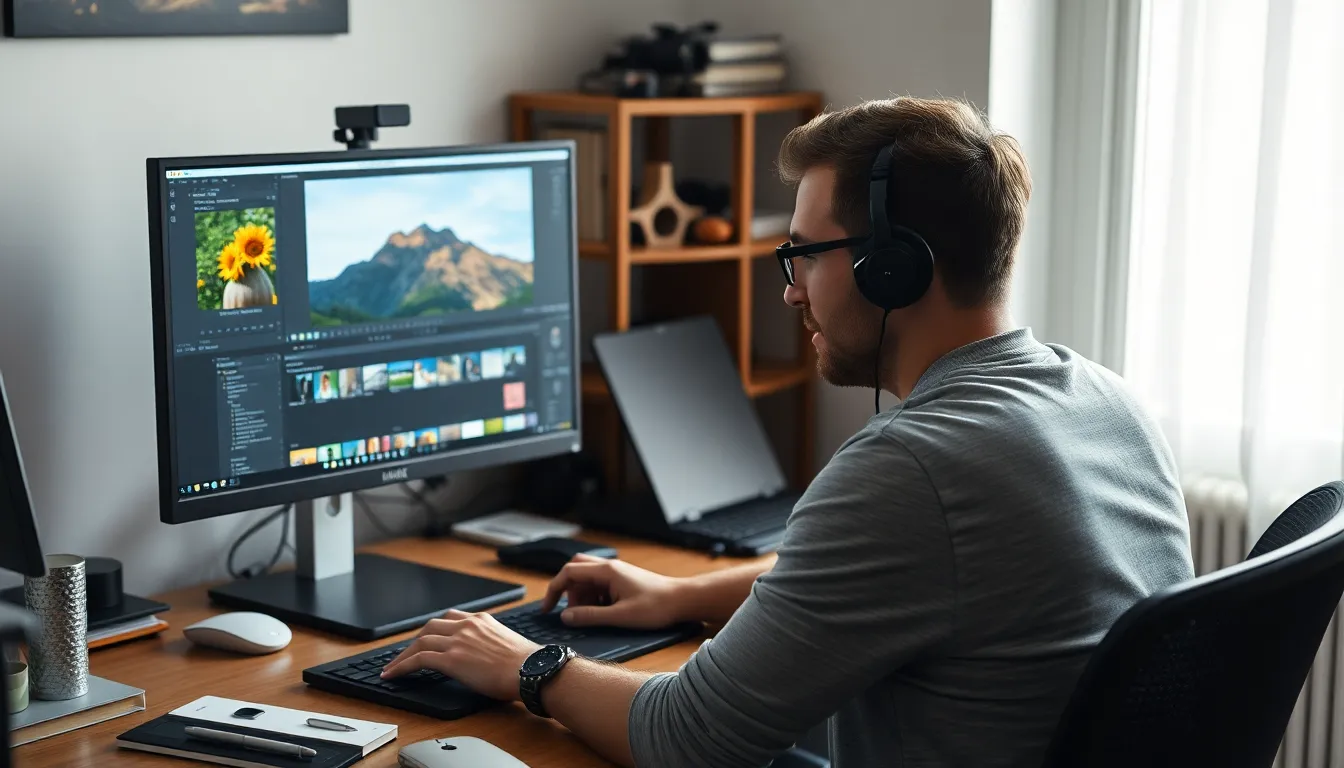Table of Contents
ToggleIn the world of photography, capturing the perfect shot is just the beginning. Editing is where the magic happens, transforming good images into stunning visual stories. But let’s face it—navigating the editing software can feel like trying to solve a Rubik’s Cube blindfolded. Fear not! With a few handy tips, anyone can elevate their editing game from “meh” to “wow!”
Essential Photography Editing Tips
Enhancing photographs through editing requires a few essential techniques. Adjusting exposure improves image brightness, revealing previously hidden details. Cropping can transform the composition, focusing attention on the main subject.
Using color correction tools can enhance the vibrancy of images, making them more visually appealing. Implementing sharpening techniques adds clarity, ensuring each element stands out.
Utilize filters cautiously; while they can create mood, overuse may detract from authenticity. Experimentation with contrast settings can define lights and shadows, adding depth to photos.
Save edits in layers to allow for non-destructive changes. This technique provides flexibility, enabling the reversion to original images if necessary. Regularly review histograms to gauge exposure levels accurately, ensuring no significant detail is lost in highlights or shadows.
Implementing a consistent style throughout an entire photo set establishes a strong visual identity. Maintaining workflow efficiency can also enhance productivity. Develop a routine that accommodates batch processing when dealing with multiple images.
Remember to frequently back up edited files to prevent loss. Organizing images into folders based on themes simplifies future access. Constant learning through online tutorials and peer feedback can yield new editing techniques and insights.
Understanding Editing Software

Editing software plays a vital role in the photo editing process. Familiarity with various tools can significantly enhance the editing experience and outcomes.
Popular Software Options
Adobe Photoshop stands out as a leading choice among professionals, offering a vast array of features for precise edits and creative effects. Lightroom, also from Adobe, provides excellent batch processing and is user-friendly for organizing photos. Capture One serves photographers who value tethering capabilities during shoots. GIMP serves as a free alternative to Photoshop, offering robust features for those on a budget. Affinity Photo gains popularity due to its one-time purchase model instead of a subscription.
Features to Look For
When selecting editing software, assess compatibility with your computer system for optimal performance. A user-friendly interface can streamline the editing workflow and enhance productivity. Look for advanced features like layer management, allowing for non-destructive edits. Built-in presets offer quick adjustments for color corrections, saving time during editing. Lastly, a strong community support system aids users in troubleshooting and learning new techniques.
Basic Editing Techniques
Basic editing techniques can significantly enhance photographic images. Mastering these skills leads to more captivating visuals.
Cropping and Framing
Cropping directly modifies image composition. It eliminates distracting elements while emphasizing the subject. Different aspect ratios may serve varied purposes, so selecting the right one is crucial. Adjusting the frame also guides the viewer’s eye toward the intended focal point. Additionally, applying the rule of thirds can improve visual balance. Professionals often experiment with different crop sizes to discover the ideal framing for their work.
Adjusting Exposure and Contrast
Adjusting exposure improves the overall brightness of a photograph. Underexposed images can appear dull, while overexposed images lose detail. Increasing contrast adds depth and makes subjects stand out. Techniques such as adjusting highlights and shadows can recover lost information. Photographers often use curves and sliders to achieve precise results. Regularly reviewing histograms ensures appropriate adjustments preserve image integrity. A careful blend of exposure and contrast settings enhances the final visual impact.
Advanced Editing Tips
Advanced editing techniques can elevate photography skills and create stunning visual narratives. Utilizing layers and masks provides flexibility and precision in edit management.
Using Layers and Masks
Layers enable photographers to separate adjustments without altering the original image. They facilitate individual edits to exposure, color, or sharpness. Masks control the visibility of adjustments, allowing selective application. Using a brush tool, one can paint over areas to enhance or diminish effects. For example, applying luminosity adjustments only to highlights enhances dynamic range while preserving shadows. Regularly renaming layers aids in identifying changes easily.
Color Grading Techniques
Color grading aligns the mood of a photo with its intended message. Photographers can manipulate color tones to evoke emotions or create stylistic effects. For instance, applying a teal-orange color scheme can enhance cinematic aesthetics. Experimenting with color balance sliders gives further control over temperature and tint. Utilizing LUTs offers preset looks that speed up the grading process. Moreover, ensuring harmonious color palettes contributes to a cohesive image set. Regular practice of color grading techniques sharpens editing skills and broadens creative horizons.
Finalizing Your Edits
Finalizing edits involves significant steps that ensure images reach their full potential. Attention to detail during this phase makes a difference.
Exporting Your Images
Exporting images requires selecting the correct file format. JPEG works well for most online usage thanks to its small size. TIFF, on the other hand, suits high-quality prints. Setting the proper resolution also matters, with 300 DPI recommended for print work. Aim for a long edge of 2000 pixels for web images. This approach ensures optimal display quality across various platforms.
Preparing for Print or Web
Preparing images for print or web involves specific considerations. For print, adjust color settings to CMYK, ensuring colors appear as intended. Always assess the paper type and printing method when preparing the final image. Convert images to the appropriate size for web use, typically under 1 MB for quicker load times. Using sRGB color space for web images ensures consistent appearance across devices. Check final images for any adjustments in exposure before exporting, guaranteeing captivating visuals for viewers.
Mastering photography editing is a journey that can significantly enhance the quality of images. By applying the tips and techniques discussed, photographers can transform their work from ordinary to extraordinary. Emphasizing the importance of workflow efficiency and continuous learning will help anyone refine their skills over time.
Experimenting with various software options and understanding their unique features can make the editing process more enjoyable and effective. With practice and attention to detail, photographers can create stunning visuals that tell compelling stories. The right editing techniques not only improve individual images but also contribute to a cohesive visual identity across a portfolio. As they continue to explore and grow in their craft, the possibilities for creativity are endless.






